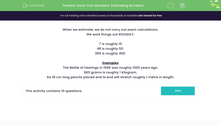In this activity, we will be learning about using estimating in maths.
When we estimate, we do not carry out exact calculations.
We work things out using approximate values.
To do this, we might round a number up or down to the closest multiple of 10 or 100.
7 and 11 are both approximately 10
48 and 51 are both approximately 50.
389 and 403 are both approximately 400.
So, if there are 396 jelly beans in a jar and Simon has two jars. How many beans does he have altogether?
396 is very close to 400.
400 is much easier to double than 396.
400 × 2 = 800.
So, we could say he has approximately 800 jelly beans.

Let's try an example question together.
Example
Benny's socks are 19 cm, 17 cm, 21 cm, and 22 cm long.
He lays them out in a line.
Approximately how long is the line?
Answer
Benny's socks are all approximately 20 cm long if we round them all to the nearest multiple of 10.
He has four pairs of socks.
20 × 4 = 80
The line of socks will be approximately 80 cm long.
.jpg)
Now you've seen estimating in action, it's time to try some questions yourself.








